Unit 06
The Ministry Of Jesus Accelerates
Chapter 02
Rejection In Nazareth
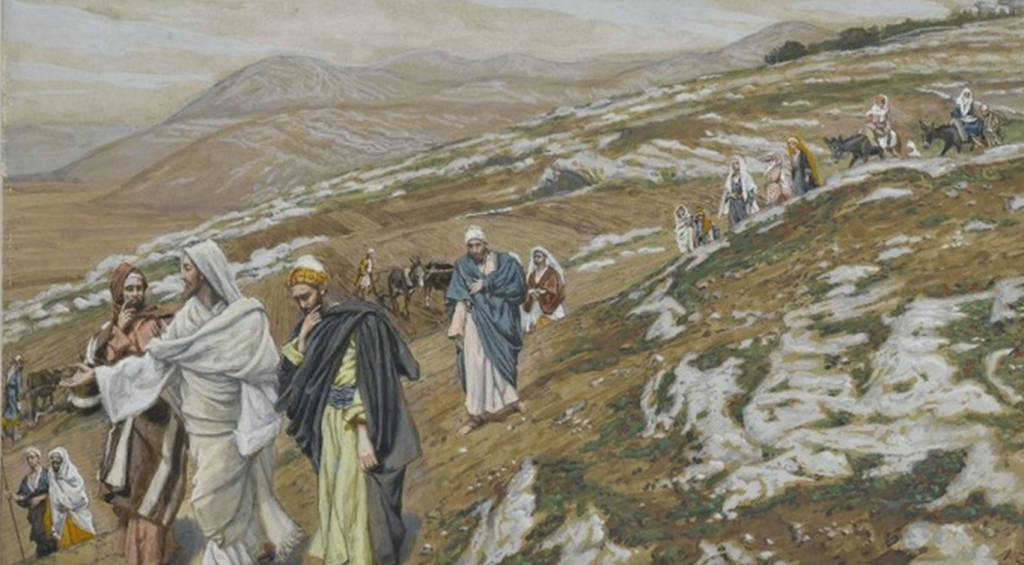 06.02.00.A. THE ROAD FROM NAZARETH TO JERUSALEM by James Tissot. 1880. Jesus teaches to various followers as He traveles across the rocky Galilee Mountains.
06.02.00.A. THE ROAD FROM NAZARETH TO JERUSALEM by James Tissot. 1880. Jesus teaches to various followers as He traveles across the rocky Galilee Mountains.
Unit 06
The Ministry Of Jesus Accelerates
Chapter 02
Rejection In Nazareth
 06.02.00.A. THE ROAD FROM NAZARETH TO JERUSALEM by James Tissot. 1880. Jesus teaches to various followers as He traveles across the rocky Galilee Mountains.
06.02.00.A. THE ROAD FROM NAZARETH TO JERUSALEM by James Tissot. 1880. Jesus teaches to various followers as He traveles across the rocky Galilee Mountains.
06.02.01 Introduction. It would be only a matter of time until Jesus went to the remote village that for so many years was His boyhood home. As He came before the congregation in the synagogue, everyone saw Him as the neighborhood kid who grew up among them. The other children He once played with were now adults and had their own children. There were people whose homes He built or repaired, for whom He constructed furniture or agricultural implements. They knew that He was a good and obedient boy, one of whom any parent would be proud.
Some admired Him while others could not forget His illegitimate birth. They believed that since He was born out of wedlock, He was ineligible for the least of any religious duties. In fact, it is a wonder that He was even permitted to read from the sacred scrolls. Maybe it was because He was such a fine young man in His youth in spite of His birth. Or maybe it was because of the miracles and the exploding popularity He attained. Regardless, now the people of Nazareth would see this young man they thought they knew so well; and they passionately listened to every word – much to their surprise.
06.02.02 Lk. 4:16-30 Nazareth
JESUS REJECTED IN HIS HOMETOWN
(The poetic section is divided in three sections)
16 He came to Nazareth, where he had been brought up,
1 A As usual, He entered the synagogue
B And stood up to read.
C 17 The scroll of the prophet Isaiah was given to him,
D and unrolling the scroll, He found the place where it is written:
2 A 18 “The Spirit of the Lord is on Me, because He has anointed Me
B to preach good news to the poor.
C He has sent Me to proclaim freedom to the captives
D and recovery of sight to the blind,
C’ to set free the oppressed,
B’ 19 to proclaim
A’ the year of the Lord’s favor” (Isa. 61:1-2a).
3 D’ 20 He then rolled up the scroll,
C’ gave it back to the attendant
B’ and sat down.
A’ The eyes of everyone in the synagogue were fixed on Him. 21 He began by saying to them, “Today as you listen, this Scripture has been fulfilled.”
22 They were all speaking well of Him and were amazed by the gracious words that came from His mouth, yet they said, “Isn’t this Joseph’s son?”
23 Then He said to them, “No doubt you will quote this proverb to Me: ‘Doctor, heal yourself. So all we’ve heard that took place in Capernaum, do here in Your hometown also.’”
24 He also said, “I assure you: No prophet is accepted in his hometown. 25 But I say to you, there were certainly many widows in Israel in Elijah’s days, when the sky was shut up for three years and six months while a great famine came over all the land. 26 Yet Elijah was not sent to any of them—but to a widow at Zarephath in Sidon. 27 And in the prophet Elisha’s time, there were many in Israel who had serious skin diseases, yet not one of them was healed — only Naaman the Syrian.”
28 When they heard this, everyone in the synagogue was enraged. 29 They got up, drove Him out of town, and brought Him to the edge of the hill that their town was built on, intending to hurl Him over the cliff. 30 But He passed right through the crowd and went on His way.
Literary style. Verses 16 – 21 are written in a poetic style of three stanzas. The first and third are of opposite patterns. In line 1A, Jesus entered the synagogue while 3A is another reference to the synagogue. In line 1B, Jesus stood up while in 3B He sat down. In line 1C, He received the scroll of Isaiah while in 3C He gave it back to the attendant. In 1D, He unrolled it but in 3D He closed it. Stanza 2 has the same structural form as 1 and 3. Note the similarities between A and A’, B and B’, etc. In fact, this stanza could be moved to the right and unified with the other two.[1]
It should be noted that poetic forms of parables may change or even be lost in translation when sentence structures change. Not all parables are shown in poetic form, but these are presented so the reader can understand the dynamics of Hebraic speech that help people memorize the stories.
“As usual.” Jesus lived in this community for most of His life and had attended the local synagogue every Sabbath. It may have had a “House of the Book” attached – a classroom for young children or the sanctuary itself may have served in this capacity six days of the week.[2] This was like a homecoming for Him, but one that would be a disappointment and most certainly cause embarrassment for His family who would not come to faith until after His resurrection.
“He entered the synagogue.” Going to the house of worship on the seventh day was what everyone did – no one even questioned it. During the week teachers taught children or their disciples in synagogues, but on the Sabbath, the entire community came to the synagogue to be taught and to worship God. Likewise Jesus taught in the synagogues and His gospel message was later commissioned to the apostles (Acts 1:8). When Paul began his ministry to the Diaspora (Jews in foreign lands),[3] he also taught in the synagogues as Jesus had done.[4] Apollos also began his ministry in the synagogue (Acts 18:26). And since Jesus preached in the synagogue, those who accepted Him as their Messiah began to worship God at home and in a synagogue service that was patterned after the traditional Jewish service.[5] Early Christian and Jewish services always began with praises, followed by prayer as stated in the Talmud:
Rabbi Simlai expounded: “A man should always first recount the praise of the Holy One, blessed be He and then pray.”
Babylonian Talmud, Berakoth 32a-32b
“[Jesus] stood up to read.” Luke takes notice of Jewish practices, as when Jesus stood to read the Scriptures and the audience always stood to listen.[6] This tradition is still practiced today. Following the reading from the Torah was a reading from the Prophets, which, in this case, was from the Book of Isaiah.[7] It was the cultural norm that, after He finished reading, He sat down to preach a sermon. What has been preserved by Luke most certainly is only a small segment of a much larger sermon presented by Jesus.
Ancient texts were usually intended for public reading, as silent reading was an unknown skill until the second or third century A.D. That is why Jesus said “Let those who have ears, listen.” He never said, “Let those who have eyes, read.” For the most part, letters and other documents were an extension of oral communication. St. Augustine, in his fourth-century Confessions, wrote that St. Ambrose was the most incredible man he had ever met because he could read without moving his lips or making a sound.
To make the matter of reading more challenging, papyrus and ink were expensive and scribes were among the highest paid professionals. Furthermore, Greek and Hebrew documents frequently had no separation of words, sentences, paragraphs, or punctuation. To read ancient texts required excellent reading skills, even by today’s standards.[8]
“To set free the oppressed.” The literal translation of oppressed is to be taken, or conquered, as begin a captured prisoner of war.[9] The allusion has two points to it:
“The year of the Lord’s favor.” This phrase is clearly reflective of the year of Jubilee, the year when all debts were to be forgiven, slaves were to be emancipated (Lev. 25:8-17), and the oppressed captives were to be given their freedom.[11] This year was to occur once every fifty years, but it was seldom honored. Jesus proclaimed that this year was symbolic of Him because He is the one who forgives debts and gives freedom to humanity. That was absolutely stunning! It is noteworthy that the English words sins and debts are both translated from the Aramaic word hoba. Therefore, when Jesus speaks of sinners He is also speaks of debtors; when He speaks of the forgiveness of sins He also speaks of speaks of the forgiveness of moral and spiritual debts.[12]
But what Jesus did not read from the scroll of Isaiah (61:2b) is equally important; He did not mention the short passage with reference to the “day of vengeance.” That passage is a clear reference to when Christ returns as king to judge the godly and ungodly. When John the Baptist thundered that One would come who would bring judgment and fire, he was right; however, that portion of his prophetic words was not to be fulfilled in the first century; it is yet to come.
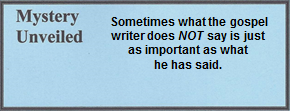
“He began by saying to them.” As previously stated, the teacher (or rabbi) would always stand to read the Scriptures and always sit down to teach the class or congregation.[13] When the reader sat down in the seat of Moses, he was in a slightly elevated position and, essentially, was seen as a type of Moses as he instructed the congregation.
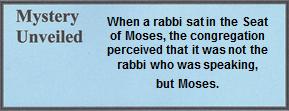
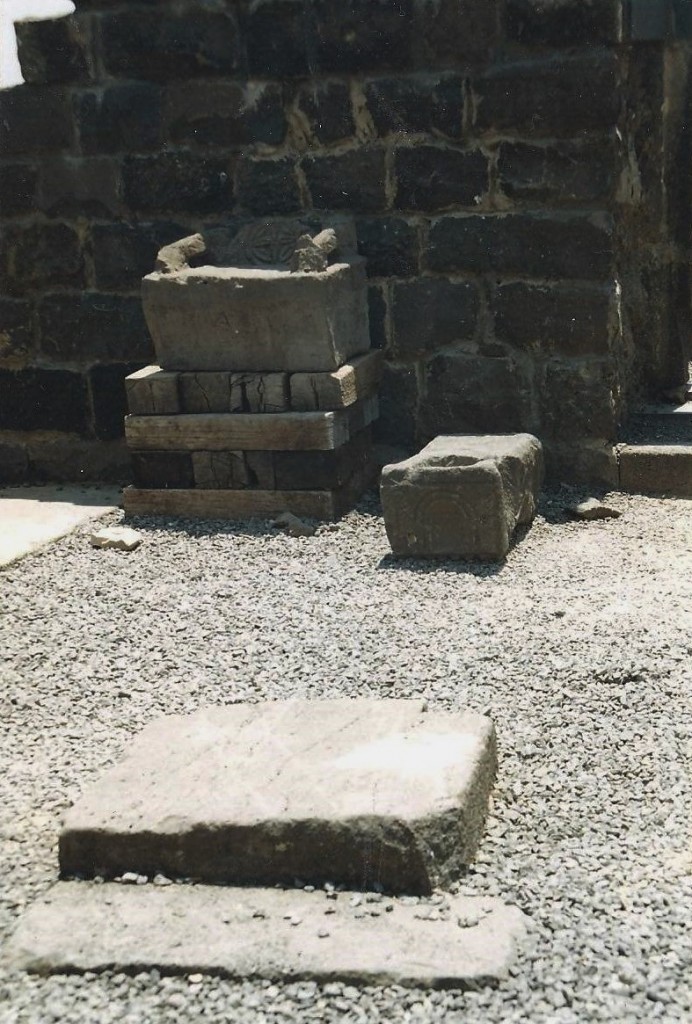
06.02.02.A. THE SEAT OF MOSES AND THE BEMA STONE. The seat of Moses (background) and the Bema stone (foreground) in the synagogue ruins at Chorizim is typical of a first century synagogue. At Nazareth, Jesus would have stood upon the Bema stone when He read the Scroll and was seated in the Seat of Moses when he explained the Scriptures to the congregation. Photograph by the author.
The Greek word Bema refers to the raised platform upon which a speaker stood to address a congregation, read proclamations, and upon which citizens stood when tried before officials.[14]
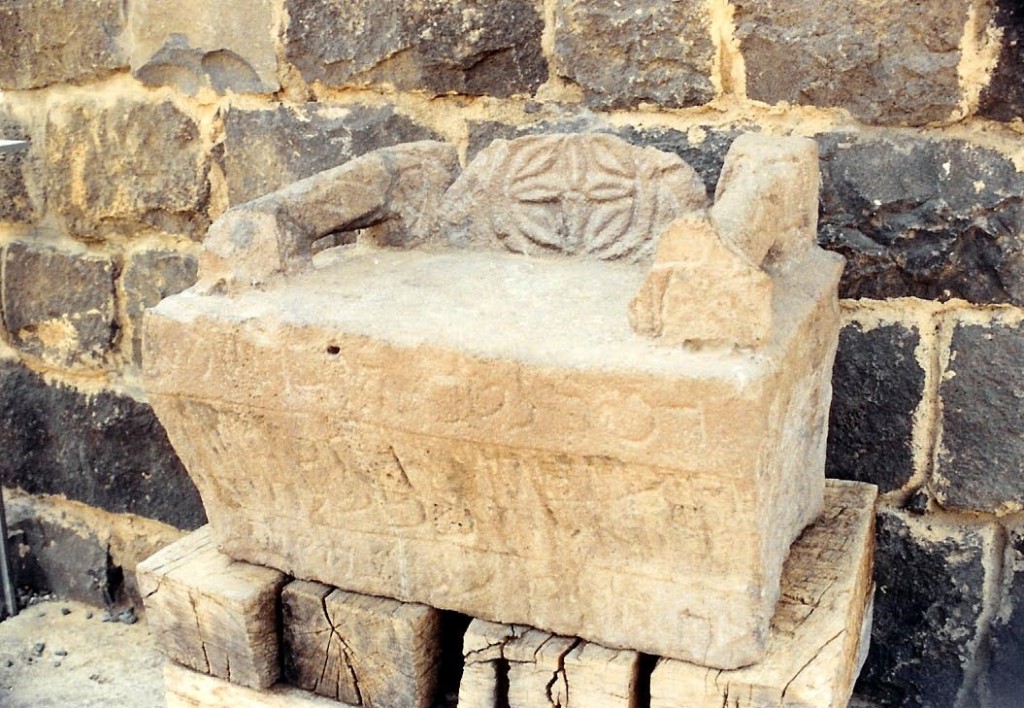
06.02.02.B. THE SEAT OF MOSES IN CHORIZIM. A close-up view of the seat where the teacher of the synagogue sat to instruct the congregation. This stone seat was discovered by archaeologists in 1926, and is the type mentioned in Matthew 23:1-3. Photograph by the author.
“Today as you listen, this Scripture has been fulfilled.” This passage from Isaiah 61 was recognized as one of the great messianic prophecies. Therefore, when Jesus said this Scripture was fulfilled in their hearing, He was announcing that He was that expected Anointed One – the Messiah! They could not imagine that a child born out of wedlock, even if He was the best kid in town, could possibly be their messiah. Consequently, there was instant anger.
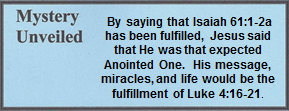
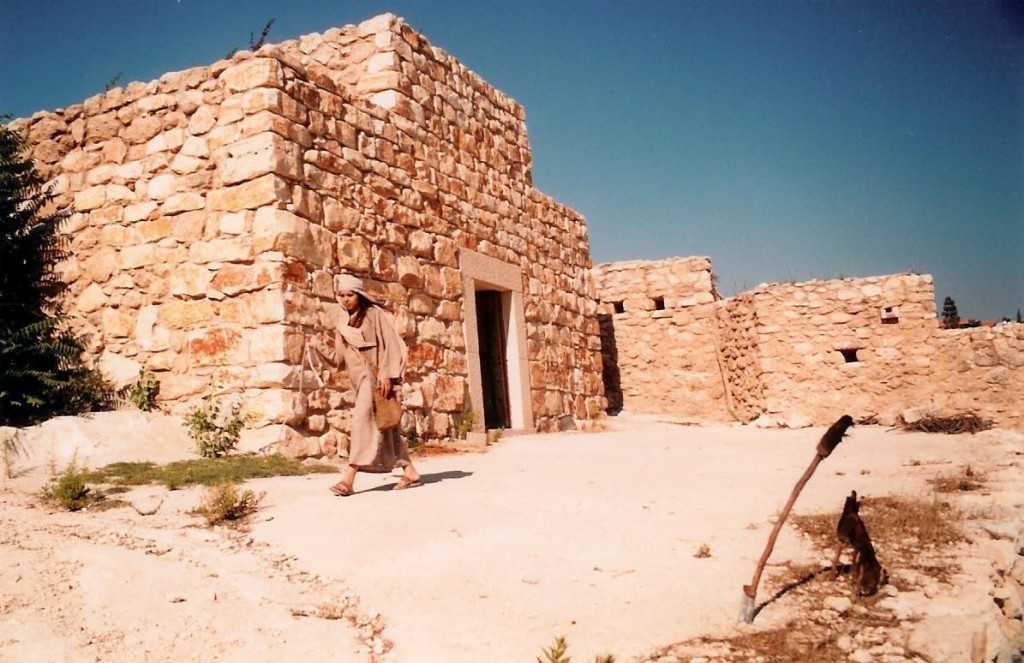 06.02.02.C. THE RECONSTRUCTED NAZARETH SYNAGOGUE. This synagogue is believed by Jewish scholars to be identical to the one that was graced by the presence of Jesus, although its location cannot be affirmed. Since the architectural style of synagogues had little or no variation from village to village, archaeologists and researchers examined the synagogue ruins at Gamla to create an authentic reproduction.[15] A man wearing first century costume walks past the reconstructed village synagogue in the Nazareth Village which received rabbinic compliments for authenticity. Photograph by the author.
06.02.02.C. THE RECONSTRUCTED NAZARETH SYNAGOGUE. This synagogue is believed by Jewish scholars to be identical to the one that was graced by the presence of Jesus, although its location cannot be affirmed. Since the architectural style of synagogues had little or no variation from village to village, archaeologists and researchers examined the synagogue ruins at Gamla to create an authentic reproduction.[15] A man wearing first century costume walks past the reconstructed village synagogue in the Nazareth Village which received rabbinic compliments for authenticity. Photograph by the author.
06.02.02.Q1 What was the unseen miracle in Nazareth (Lk. 4:16-17)?
The tradition was that men of the congregation would take turns reading Scripture in the worship service, unless there was a visiting guest, then he was given the honor to lead the service. The readings from the scrolls were continued from week to week and, in any three year cycle the entire Hebrew Bible was read. That, in itself, was a difficult task to accomplish since there were no chapter and verse divisions. Furthermore, there were no vowels and all the letters were run together.[16] It is normally assumed that Jesus simply selected a text from Isaiah, read it, and applied it to Himself. Clearly, this was not the case. At the point where the reader of the previous Sabbath ended, that was the beginning point for the reader the following week. The miracle lies in the fact that Jesus did not select the text, but His reading was the continuation from the reading of the previous Sabbath. This was hardly a coincidence, but a miracle by a divine appointment. One would hardly notice a miracle had occurred unless the order of synagogue worship was known. The custom of the day was as follows:[17]
Jesus was probably seated in the front of the congregation during the first two steps, then read a section from the Torah (step 3). It is unknown if He read that section or if He entered the synagogue in time to read from the Prophets (step 4). Regardless, He then stood upon a large flat stone in the front of the synagogue called the “bema” (Heb. bima) stone.[19] This was the honorable position of a maphtir or reader (who at this moment was Jesus) of the sacred megillah, meaning the scroll of the prophet Isaiah. Jesus then read the haphtarah, or the reading of the day, which was Isaiah 61:1-2a. As He read, the entire congregation stood to honor the Word of God. The length of the haphtarah was normally between three and twenty-one verses. However, Jesus only read one and a half verses, rolled up the megillah, and gave it to the chazzan or the attendant, who carefully placed the sacred writing in a painted ark.[20]
After the unusually short reading, Jesus stepped off the bema stone, walked to the Seat of Moses, and seated Himself.[21] There He presented His sermon based on that Scripture (Isa. 61:1-2a). His lifelong friends and neighbors could hardly believe that the little boy Jesus, who grew up in their community, was applying the words of Isaiah to Himself. They knew of the miracles He had already performed, but when He reminded them that Elijah and Elisha performed miracles for their non-Jewish neighbors who believed God, that brought instant anger and fury. The unspoken message was that the pagans could become believers while they, the Jews of Nazareth, might not.
The first century Jewish philosopher, Philo, preserved a description of a synagogue service that was typical of the time of Jesus. He recorded the following:
Now these laws they are taught at other times, indeed, but most especially on the seventh day, for the seventh day is accounted sacred on which they abstain from all other employments, and frequent the sacred places which are called synagogues, and there they sit according to their age in classes. The younger sitting under the elder and listening with eager attention in becoming order.
Then one, indeed, takes up the holy volume and reads it, and another of the men of the greatest experience comes forward and explains what is not very intelligible, for a great many precepts are delivered in enigmatical modes of expression, and allegorically, as the old fashion was; and thus the people were taught piety, and holiness, and justice, and economy, and the science of regulating the state, and the knowledge of such things as are naturally good, or bad, or indifferent, and to choose what is right and to avoid what is wrong, using a threefold variety of definitions, and rules, and criteria, namely, the love of God, and the love of virtue, and the love of mankind.
Philo, Every Good Man is Free 12.81-83[22]
The attendant was in charge of the service. It was his responsibility to insure the appointed people read Scripture at the appropriate times, to see that the furniture and building were kept in good order, and to make sure the entire service was conducted properly and in order.[23] This form of a Jewish worship service became the pattern of worship in the early church, since the first converts were Jews. Jews wrote the first church hymns, some of which eventually were entered into Scripture (i.e. Phil. 2:6-11; 1 Tim. 3:16).[24]
“A widow at Zarephath … many in Israel who had serious skin diseases (leprosy).” At this point, the Master Teacher reflects upon the prophet Elijah and the miracle God performed through him to benefit the widow of Zarephath of Sidon. There is also a poetic reflection concerning the healing of Naaman, the Syrian leper. Note the comparisons:[25]
1 Kings 17:1-16
There were many widows in the land of Israel
In the days of Elijah the prophet
But none of them were healed
Except in Zarephath, the widow of Sidon
Luke 4:25-27; cf. 2 Kings 5:1-15
There were many lepers in the land of Israel
In the days of Elisha the prophet
But none of them were healed
Except in Syria, Naaman the leper
The audience could not help but notice the powerful connection of what they had heard and seen with the miraculous stories in their Hebrew Bible. Everyone had heard of the honored prophets Elijah and Elisha, and now they were asked to connect Jesus with the greatness of these prophets.
Leprosy was the name given to a wide range of skin diseases, but the malignant skin disease of horrors was known by the Greek name of lepra and the Hebrew name of sara’at. This is the condition described in Matthew 8:3; Mark 1:42, Luke 5:12 and translated in the Revised Standard Version as “full of Leprosy.” The New English Bible translates the term as “covered with leprosy.” Its conditions include scaly skin with swelling, discharge, ulcers, loss of hair, odor, and loss of pigmentation.[26] This condition leads to an agonizing death. The significance of this discussion was that Jesus hinted that what the Jews will reject, the Gentiles will accept.
Finally, throughout the biblical period there was a prevailing idea that gods were territorial; that there were gods who controlled various cities and regions. Therefore, it is amazing that the widow of Zarephath believed that Elijah could perform a miracle in the land of Baal. In light of that, it is even more amazing is that she gave him – a prophet of a foreign god – her last loaf of bread.
Likewise, Naaman, who had leprosy but was not confined to a leper’s colony, believed that a foreign god would help him. His healing only occurred after the encouragement of his servant, but he finally had faith to step into the Jordan River for his healing. The faith expressed by the widow and Syrian general surpassed that of the citizens of Nazareth. Both were Gentiles, both are heroes of the Jewish faith, and to tell this to the Jews of Nazareth greatly angered them.
“Everyone in the synagogue was enraged.” The many friends and neighbors were extremely hostile to one of their own equating Himself with God. However, how did His family feel? For years they tried to live in this small village in peace and harmony, but the gossip about Jesus having been conceived out of wedlock continued. It was in His hometown where the Jews first considered killing Him.[27] The primary reasons for their hatred were:
Jews considered them condemned. Yet they should have recognized that their own Scriptures prophesied the Messiah would bring salvation to the Gentiles.[28]
The rejection of Jesus most certainly had an effect on His half-brothers and half-sisters. It can safely be assumed that by this time they would have married and established homes in Nazareth or nearby villages such as Cana. In those days young married families remained close to the clan or extended families. Since the neighbors so severely rejected Jesus, they most certainly rejected and ridiculed His family as well. That was the norm of the day. Jesus was confronted by several people groups, namely:
(removed by Herod the Great), but spied on Him.
However, at a time when the Romans were quick to execute anyone whom they suspected to be the political-religious Messiah, they never confronted Jesus. They had their spies such as the Herodians, observing Jesus, but they never felt threatened.
Finally, this may be a good place to comment about women in the Galilean synagogue. The stringent rules of Jerusalem were considerably more relaxed in Galilee. While in Jerusalem women were required to remain silent during synagogue services; in Galilee synagogue leaders were more lenient:
or comment on the Torah reading.
The fact that men and women had equal opportunity to read during the Sabbath service is indicative that boys and girls both went to school to learn how to read. This was quite unusual, not only in the Greco-Roman world, but for many other Jewish communities as well. Second to Jerusalem, Galilee had become the primary academic center of Israel and, after the destruction of the temple, the seat of rabbinic authority relocated to nearby Tiberias. In fact, all the major sages in Jerusalem were from the Galilee area. With education held in such high esteem, women were welcomed in the academic community.
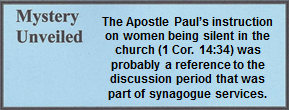
06.02.02.Q2 The Sabbath Day’s walk – How far did they take Jesus (Lk. 4:29)?
The synagogue leaders were so angry at Jesus, that they wanted to take Him “to the edge of the hill” and throw Him over it to His death. In recent years tourists have been shown a huge cliff south of Nazareth and are told this was where the Jews wanted to throw Jesus. But the southern cliff account is a myth.
In reality, the first century event would have been a retaining wall that wasn’t much higher than possibly two to four meters – or just over a man’s height. Being thrown over such a small cliff would not have been a fatal fall, but He would then have been stoned to death. That is the cultural context according to research conducted by the reconstructed Nazareth Village, and this miniature cliff or retaining wall was either in Nazareth or right along the edge of it.[33] While its location has been lost in history, these men were observant Jews and would not have broken any Sabbath laws (including those that pertained to a Sabbath walk) to drag Jesus to the huge cliff on the southern side of Nazareth.
The Sabbath Day’s walk traveling restrictions were established centuries earlier. Joshua 3 contains the account of the Israelites crossing the Jordan as they were about to enter the land God had promised them. At that time the priests carried the Ark of the Covenant, which represented the presence of God in their midst. The people were told by the famous leader, Joshua, not to get closer than two thousand cubits (about one thousand yards) from the ark (Josh 3:4a). Therefore, on the Sabbath Day one could not travel more than a thousand yards from the center of worship so as not to become distant from God. Especially since the term Sabbath means rest.[34] Since the “center” was considered to be the home, synagogue, or other place in the village, the rabbis would place markers indicating the end of two thousand cubits along the roads leading in and out of every village. On the Sabbath Day, the villagers could walk to the marker that indicated the limit of the distance they could travel.[35]
However, apparently there was some variation concerning the length of a Sabbath’s Day’s journey. Acts 1:12 indicates the distance from the Mount of Olives to Jerusalem as a Sabbath Day’s walk. Josephus cited this distance as five furlongs or 3,031 feet[36] and again as six furlongs (a/k/a six stadia/stadium) or 3,637 feet.[37] But it is doubtful that when Luke wrote Acts 1:12, he was interested in a precise measurement.
In addition, a great disparity of distance lies in the fact that by Hellenistic measure 2000 cubits is 3000 feet. The variation may be due to the fact that while a cubit was generally 17.49 inches,[38] in some cases it was 21.5 inches. But the most common unit of measure was the shorter unit. For general purposes, two cubits equal 36 inches or one yard as referred to in Joshua 3:4b. For Romans, a journey of 2,000 cubits (Num. 35:5), was reckoned to be equal to six Roman stadia (606.5 feet). Jerome in his Epistle to Algasian (Book 10) recorded the Sabbath Day journey to be a distance of 2000 feet.[39] Obviously, there were different opinions as to a precise distance, but there was a consensus of the approximate distance.
Today tourists in Israel see a quarry on the south side of the mountain upon which Nazareth rests and are told this is the cliff where Jesus was threatened. However, when examining the distance between Nazareth and the “traditional cliff” as determined by the Crusaders, there is no question this was far beyond any Sabbath’s Day journey, even by the most liberal interpretation. Hence, the so-called traditional cliff location needs to be removed from any consideration as a historical-religious site.
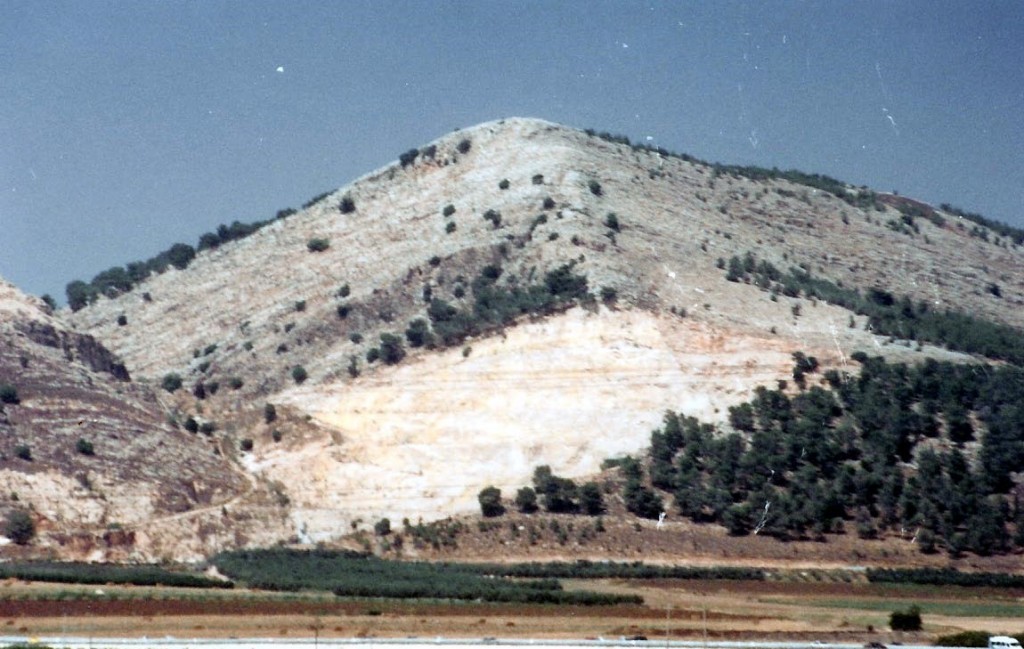
06.02.02.D. THE “TRADITIONAL CLIFF” OF NAZARETH. The cliff south of Nazareth, according to Crusader traditions, is identified as being where the congregation of Nazareth challenged Jesus. However, this cliff is far beyond the traditional “Sabbath’s day walk” from the ancient synagogue and, therefore, cannot be considered as the site. It is a classic example of the many traditional myths of the Holy Land. Today it is an active quarry. Photograph by the author.
The people He grew up with; the neighbors He loved and cared for; the kids He once played with who now had children of their own; for the most part, rejected Him. He saw friendly faces and critical eyes. Jesus left His hometown with a heavy heart and moved to Capernaum. The humble home that was His for so many years would be no more. Yet of all the human emotions that filled His heart, He knew that eventually the Jewish leadership would do likewise – turn against Him. The passage in Isaiah expressed His own purpose and program – precisely what He was going to do with His life – the Kingdom of God as follows:
spiritually blind to the truth (v. 18).
It is noteworthy that little is recorded in the Bible concerning the relationship Jesus had with His biological family. It appears, however, that His brothers and sisters still had some serious misgivings about Him at this point. In fact, His brother James was as much, if not more, of a doubter as was the famous doubting Thomas until after the resurrection. His mother and father, assuming Joseph was still alive, were the only family members who had any confidence in Him. Thus, the poetic words of David were fulfilled.
I have become a stranger to my brothers
and a foreigner to my mother’s sons.
Psalm 69:8
There are times when one must move on to the next phase of life. So did Jesus, as now He proceeded to the northern edge of the Sea of Galilee where He spent considerable time teaching and performing miracles. So much so, that the region between the villages of Tabgha, Bethsaida, and Chorizim became known as the “evangelical triangle.” Capernaum was centered within this evangelical area.
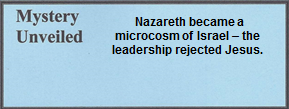
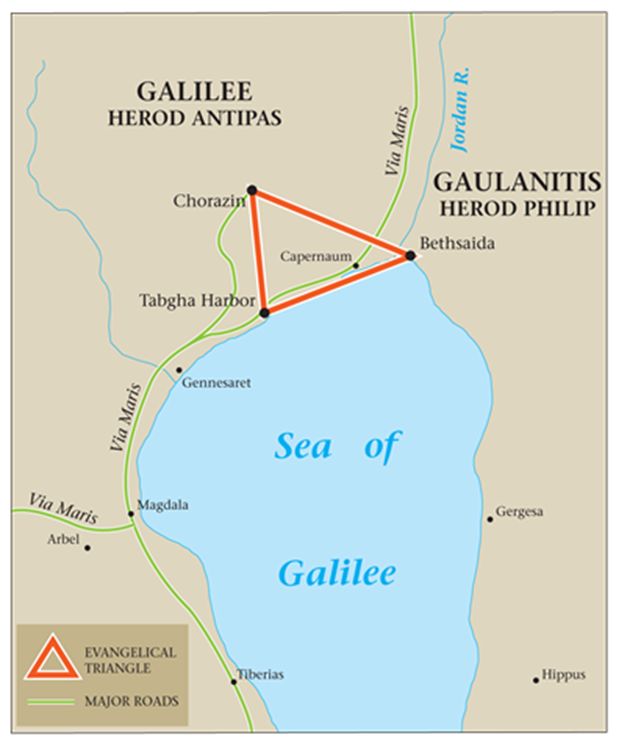
06.02.02.Z MAP OF THE EVANGELICAL TRIANGLE. The area of three villages where Jesus ministered most frequently formed what has been called the “Evangelical Triangle.” These villages were Tabgha, Bethsaida, and Chorizim, located in the area along the northern edge of the Sea of Galilee with Capernaum in the center. Courtesy of International Mapping and Dan Przywara.
Finally, two of the Dead Sea Scroll fragments have amazing reflections upon Luke 4:16-30, although that passage is based upon selections from Isaiah 61. The fragments indicate that the Essenes apparently believed that Isaiah’s words were messianic in nature, and when they wrote them, they did so in a similar manner to what Luke did.
Fragments 4Q278 & 4Q521[40] Luke 4:16-30
The Holy Spirit rests The Spirit of the Lord is on Me
The Messiah is exalted For He has anointed Me
[i.e., made me into Messiah]
To preach the good news to the poor To preach the good news to the poor
Release for the captives Release for the captives
Opening the eyes of the blind Opening the eyes of the blind
Raising up the downtrodden Set free the oppressed
His mighty works: heal the sick What we have you did at
Capernaum do also here
[i.e., heal the sick]
His works: Raising the dead Affirms the raising of the dead as a messianic act of Jesus[41]
[1]. Bailey, Poet and Peasant. Part I, 68 and Part II, 104; Fleming, The Parables of Jesus. 15, 23; Pilch, The Cultural Dictionary. 73.
[2]. Bookman, When God Wore Sandals. CD Trac 1.
[3]. Mills and Michael, Messiah and His Hebrew Alphabet. 104.
[4]. Acts 13:5; 14:1; 17:1, 10, 17; 18:4, 19.
[5]. See Philo, The Works of Philo. 689-90 quoted in 06.02.02.Q1. Also Martin, Worship in the Early Church. 24. Lightfoot, A Commentary on the New Testament from the Talmud and Hebraica. 3:67; Geikie, The Life and Works of Christ. 2:3-4; Farrar, The Life of Christ. 118-20; See the book of Jubilees for the tiresome instruction on the minutest rabbinical details presented in synagogue services.
[6]. For a study on the synagogue worship service, see Alfred Edersheim, The Life and Times of Jesus the Messiah. (Peabody, MA: Hendrickson Publishers, 1993). This reprint of the 1883 edition remains a classic resource.
[7]. Bivin, “The Rejection of Jesus at Nazareth.” Yavo Digest. 3:4, 13.
[8]. Witherington, Living Word. 173.
[9]. Vincent, Word Studies in the New Testament. 1:291.
[10]. See 02.01.03.Z “Map Of The Two Jewish Diasporas.”
[11]. For further study of loans, debts, and how first century Jewish courts ruled, see the Mishnah and the chapter titled Baba Bathra.
[12]. Bailey, Jesus through Middle Eastern Eyes. 252.
[13]. Bivin, “The Rejection of Jesus at Nazareth.” Yavo Digest 3;4, 3.
[14]. Mt. 27:19; Jn. 19:13; Acts 18:12-17; 25:1-12; Franz, “God’s Gold and the Glory of Philippi.” 118.
[15]. Syon, Danny. “Gamla: Portrait of a Rebellion.” 30-33.
[16]. A system of “vowel points” was established in the 9th or 10th century (A.D.) to aid reading.
[17]. Farrar, Life of Christ. 103; Martin, Worship in the Early Church. 67-70.
[18]. Lightfoot, A Commentary on the New Testament from the Talmud and Hebraica. 1:152.
[19]. Martin, Worship in the Early Church. 67-70.
[20]. Farrar, Life of Christ. 102; Lang, Know the Words of Jesus. 276, 308-09; Moseley, Yeshua: A Guide to the Real Jesus and the Original Church 9.
[21]. The custom of being seated while teaching is also found in Mt. 5:1, 23:2, 26:55; Jn. 8:2; Acts 22:3.
[22]. Philo, The Works of Philo. 689-90. See also Martin, Worship in the Early Church. 24. Lightfoot, A Commentary on the New Testament from the Talmud and Hebraica. 3:67.
[23]. Freeman, The New Manners and Customs of the Bible. 503.
[24]. Martin, Worship in the Early Church. 18-20.
[25]. For further study, see Bailey, Jesus through Middle Eastern Eyes. 160-68.
[26]. Harrison, “Leprosy.” 2:463-66. See also Lightfoot, A Commentary on the New Testament from the Talmud and Hebraica. 3:78.
[27]. Others references are Jn. 5:16; 7:30; 8:40, 59; Lk. 11:53-54.
[28]. Isa. 9:1-2; 42:1-3, 6-7; 60:1-3; also note Mt. 4:13-16; Acts 13:47.
[29]. For further study on the various opinions concerning the status and influence of women in the Second Temple Period, see the excellent work by Tal Ilan, Integrating Women into Second Temple History, Peabody, MA: Hendrickson, 1999.
[30]. Safrai, Shmuel. “The Place of Women in First-Century Synagogues,” Jerusalem Perspective. 40 (1993): 3-6, 14; See also Spangler and Tverberg, Sitting at the Feet of Rabbi Jesus. 12.
[31]. For synagogue service procedures, see Philo, The Works of Philo. 689-90 quoted in 06.02.02.Q1. Also Martin, Worship in the Early Church. 24. Lightfoot, A Commentary on the New Testament from the Talmud and Hebraica. 3:67; Geikie, The Life and Works of Christ. 2:3-4; Farrar, The Life of Christ. 118-20. See the book of Jubilees for the tiresome instruction on the minutest rabbinical details presented in synagogue services.
[32]. Cited by Fischer, The Gospels in Their Jewish Context. (Lecture on CD/MP3). Week 7, Session 1.
[33]. Information was acquired by personal interviews with Nazareth Village staff on June 9, 2013. Nazareth Village is a recreated first century living museum in Nazareth, Israel.
[34]. Josephus, Antiquities 1.1.1.
[35]. For additional Sabbath regulations, see Jubilees 50:6-13 at 02.04.06. In fact, during the Maccabean Revolt, since the Jews refused to fight on the Sabbath, the Greeks slaughtered more than a thousand men, women, and children. Thereafter they decided to defend themselves so as not to be removed from the face of the earth (1 Macc. 2:31-38).
[36]. Josephus, Antiquities 20.8.6.
[37]. Josephus, The Jewish Wars 5.2.3. Some other sources indicate 3,639 feet instead of 3,637 feet.
[38]. See Appendix 20; Some sources indicate the Old Cubit, a/k/a Short Cubit, was 17.49, 17.6, or 17.71 inches, or 45 cm.; See also Vine, “Cubit.” Vine’s Complete Expository Dictionary. 1:53.
[39]. Kepler, “Sabbath’s Day’s Journey” 4:141; Geikie, The Life and Words. 2:622.
[40]. The comparison of Luke 4:16-30 with DSS 4Q278 and 4Q521 was adapted from Bailey, Jesus through Middle Eastern Eyes. 150.
[41]. For more information on the messianic acts / messianic miracles, see 06.03.08.Q1, 06.03.08.Q2, 06.01.03, John 4:25 as well as the related video link 06.03.08.V; Fruchtenbaum, Messianic Miracles. 4.
Unit 06
The Ministry Of Jesus Accelerates
Chapter 03
The Ministry Of Jesus Accelerates In Galilee
06.03.00.A. JESUS AND HIS DISCIPLES IN A FISHING BOAT. Artwork by William Hole of the Royal Scottish Academy of Art, 1876. After toiling all night without catching a single fish, Jesus, who was not a fisherman, told them where to cast the net (Lk. 5:1-7). The result was phenomenal.
06.03.01 Lk. 5:1-11; Mt. 4:18-22 (See also Mk. 1:16-20) Sea of Galilee (Gennesaret)
PETER AND THE CATCH OF FISH
Lk. 1As the crowd was pressing in on Jesus to hear God’s word, He was standing by Lake Gennesaret. 2 He saw two boats at the edge of the lake; the fishermen had left them and were washing their nets. 3 He got into one of the boats, which belonged to Simon, and asked him to put out a little from the land. Then He sat down and was teaching the crowds from the boat.
4 When He had finished speaking, He said to Simon, “Put out into deep water and let down your nets for a catch.”
5 “Master,” Simon replied, “we’ve worked hard all night long and caught nothing! But at Your word, I’ll let down the nets.”
6 When they did this, they caught a great number of fish, and their nets began to tear. 7 So they signaled to their partners in the other boat to come and help them; they came and filled both boats so full that they began to sink.
8 When Simon Peter saw this, he fell at Jesus’ knees and said, “Go away from me, because I’m a sinful man, Lord!” 9 For he and all those with him were amazed at the catch of fish they took, 10 and so were James and John, Zebedee’s sons, who were Simon’s partners.
“Don’t be afraid,” Jesus told Simon. “From now on you will be catching people!” 11 Then they brought the boats to land, left everything, and followed Him.
Mt. 18 As He was walking along the Sea of Galilee, He saw two brothers, Simon, who was called Peter, and his brother Andrew. They were casting a net into the sea, since they were fishermen.
19 “Follow Me,” He told them, “and I will make you fish for people!”
20 Immediately they left their nets and followed Him.
21 Going on from there, He saw two other brothers, James the son of Zebedee, and his brother John. They were in a boat with Zebedee their father, mending their nets, and He called them. 22 Immediately they left the boat and their father and followed Him.
These two passages from Luke and Matthew were two separate events. They happen to be placed together due to their similarities. However, before discussing the biblical passage, some background information is needed relative to fishing in the Sea of Galilee. Simon Peter and his brother Andrew were fishermen and James and John, the sons of Zebedee, were their business partners. The fish they caught were usually dried, salted and sold to traveling caravans while fresh fish were taken quickly to nearby markets such as Tiberias, Nazareth, and Sepphoris. Their business did not make them wealthy, but did provide for all their needs. Yet soon they would find sufficient reason to leave the business to Zebedee and follow Jesus.
Then Jesus, who was not a fisherman, came by and gave some instruction to professional fishermen that produced outstanding results. A huge catch of fish in daylight was caught when fish are normally caught only at night. Since the Sea of Galilee has always been abundant with fish, failure to catch any at night was unheard of and, therefore, a miracle. At night the fish swim close to the surface to feed, but during the daylight hours they descend to the depths of the lake. It was common knowledge that daylight fishing was an exercise in futility. For a carpenter to tell professional fishermen how to fish was totally out of character, especially during daylight hours – a most unusual event.
Therefore, when Jesus called Simon Peter and his brother Andrew to follow him, they knew they were going with Someone special. Yet they would not know to what extent “special” was until after His death and resurrection. John 1:35 indicates that Andrew was a disciple of John the Baptist, and possibly Peter as well. Little wonder then, that when Jesus spoke to Simon Peter, Peter addressed Him as “Master.”
It has been said that a great man can transform ordinary people into great people. The lives of the disciples would be transformed dramatically – beyond their wildest dreams. In the course of time, their human frailties would be exposed, but the power of God would transform them into healers of the sick and soldiers of the cross.
As to the profession of fishing, the trammel net was the ideal net for use at night. It is a series of three nets close together, which are “hung” in the water like a vertical curtain. Along one edge is a series of floats and along the opposite edge is a series of weights. The net is suspended in a semi-circular fashion near the shore and slowly the two ends are drawn together causing many fish to be caught.[1] At night the fish swim between the nets and become tangled. This type of net, while very effective for catching fish, also catches seaweed and “unclean” fish. Therefore, the net needs to be cleaned and unacceptable fish removed.
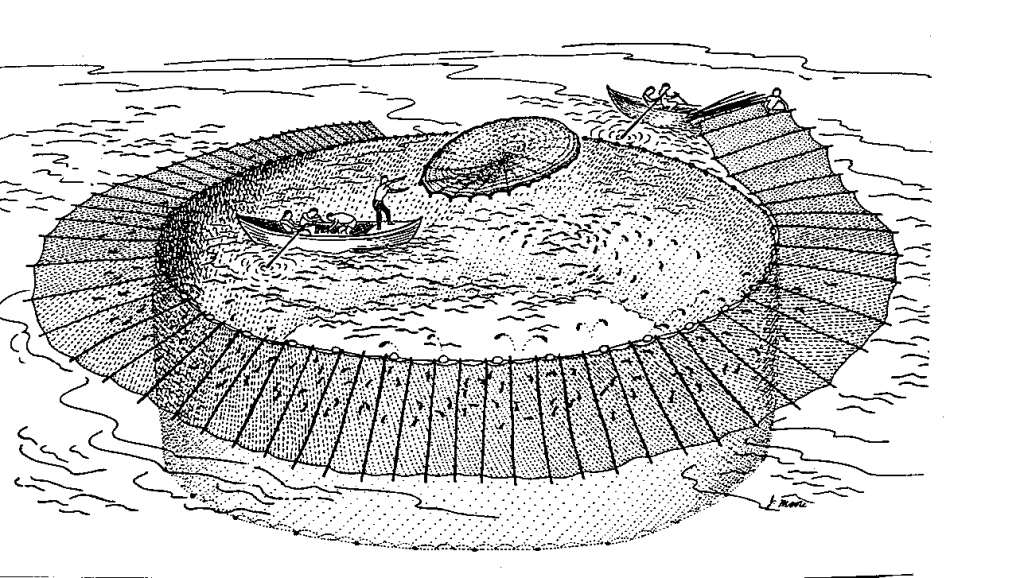
06.03.01.A. AN ILLUSTRATION OF NIGHT FISHING WITH A TRAMMEL NET. This illustration shows the trammel net being hung in the water in a circular manner.
In summary, there are two important aspects to this miracle.
Jesus clearly demonstrated his authority over nature and creation; they recognized Him as having some unusual divine powers which caused Peter to immediately confess himself as a sinful man (v. 8). The irony is that Peter, while catching dozens of fish into his net, was himself caught in the net of Jesus. Peter’s view of Jesus was more than that of a teacher, as he called Him “Master,” In contrast to John, who called Him “Rabbi.” At a future time Peter received a second calling when a “Stranger” along the shore told him to recast his net and that resulted in a catch of 153 fish.
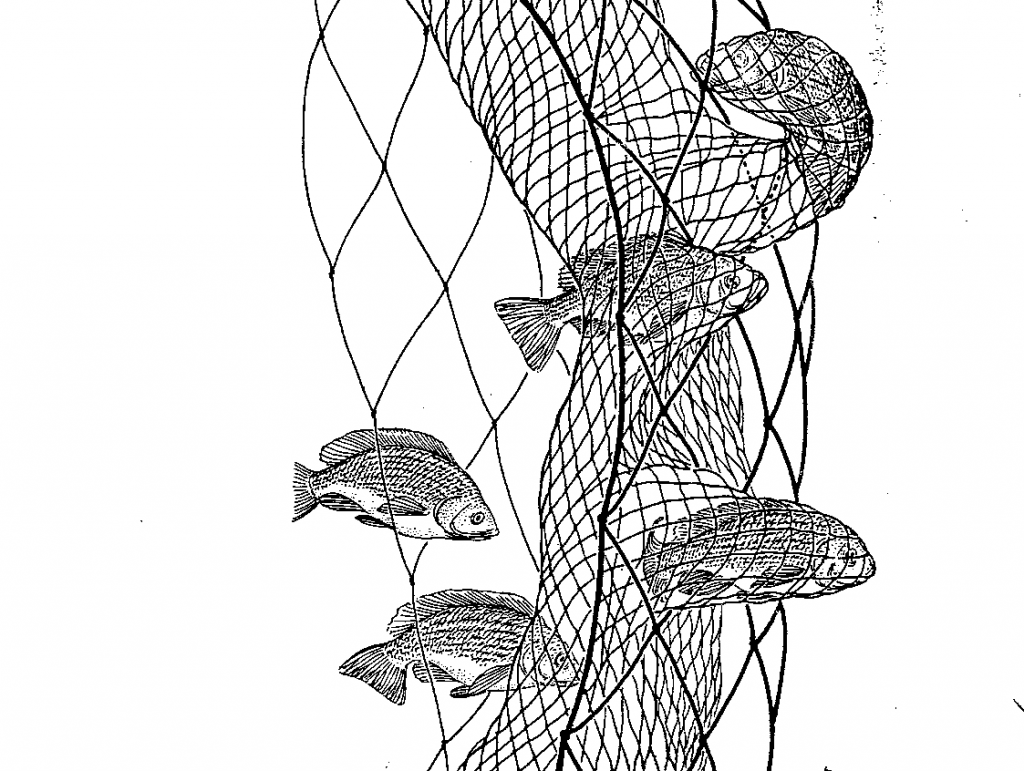
06.03.01.B. AN ILLUSTRATION OF HOW FISH ARE CAUGHT IN A TRAMMEL NET. A trammel net is a three-layered net in which the fish become tangled and caught. Fishing was done close to the shore at night when the fish could not see the linen net. Today nylon nets are used for day fishing because the fish cannot see them.
Video Insert >
06.03.01.V Insights into Two Fishing Miracles. Gordon Franz discusses the fishing miracles of Luke 5:1-11 and Matthew 4:18-22.
“’Master,’ Simon replied.” Luke used the Greek word epistates, which means teacher, boss, or master. Simon Peter clearly recognized that he was speaking with someone who had unusual authority and power. In verse 5 Simon Peter called Him kyrios, meaning Lord.[2]
There is a second type of net that is occasionally used in the Sea of Galilee. When Matthew said, “They were casting a net into the sea,” he was referring to a cast-net that in Greek is amphiblestron.[3] A cast-net is any net that is thrown around or over something to restrict its motion and was used for fishing as well as for wild game and even people in games or war.[4]
In Matthew it was the casting net (Gk. amphiblestron 293)[5] that was laid over the shoulder of the fisherman, who then cast it carefully into the water from the shore or a boat.[6] It was ideally used at night when the fish did not see the net coming all around them and they were trapped inside. The net was then pulled ashore and the fish were separated – the bad from the good.[7] This parable teaches there will be a time when God will separate the bad from the good – it is the tenor of the Bible, along with the encouraging call to follow the ways of our Lord.

06.03.01.C. CASTING A STANDARD CASTING NET. Fishermen today still cast their nets as they did in the time of Jesus. Photograph by Jeane Conte.
If Jesus would have been a typical rabbi, He would have asked the disciples to learn the Torah, become competent of the Oral Law, master the hermeneutics of biblical interpretation, and memorize the traditions and quotations of previous important rabbis. But rather, Jesus simply said, “Follow Me.” They did and “immediately they left.” This phrase illustrates the commitment the disciples had because the fishing nets were expensive. But they would simply not leave anything of such value lying on the shore. In all probability, their father Zebedee took the nets and continued the fishing business. The miracle was to be seen later as the backdrop or metaphor of the time when they would become fishers of men.
Finally, it should be noted that Satan is also a fisherman (2 Tim. 2:26) and desires to catch men. He is the impersonator of Christ, luring as many as he can with his counterfeit deeds and message.
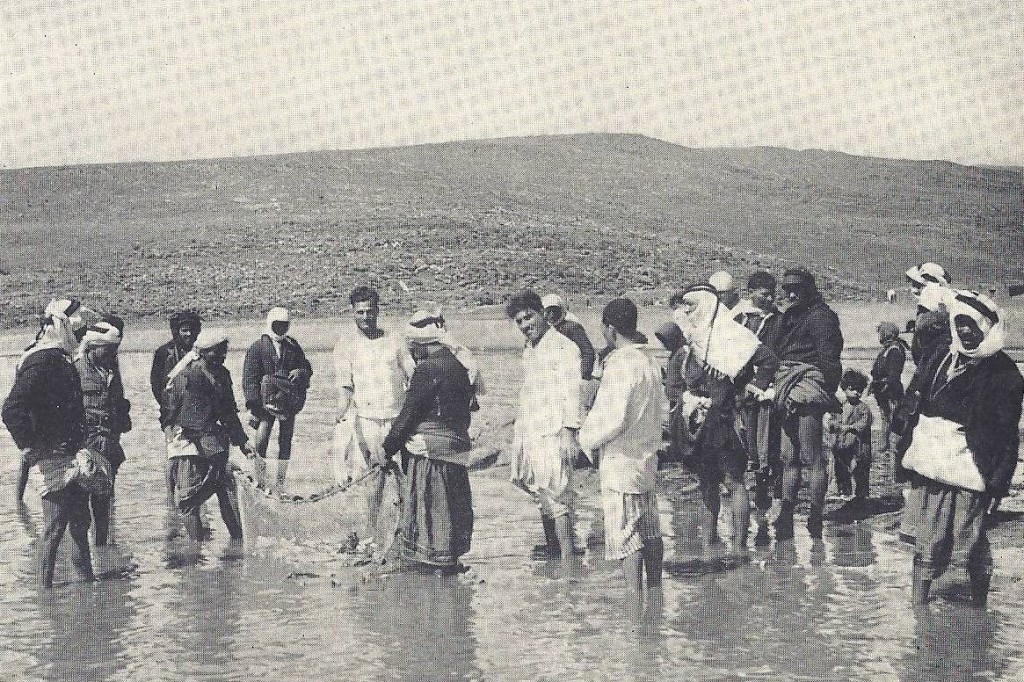
06.03.01.D. CLEANING FISHING NETS. Arab fishermen in the 1920s are shown cleaning their nets in the Sea of Galilee in a similar manner as was done in the first century. Cleaning involves the removal of unwanted fish and vegetation. Note the barren hillside in the background. Photograph by H.V. Horton.
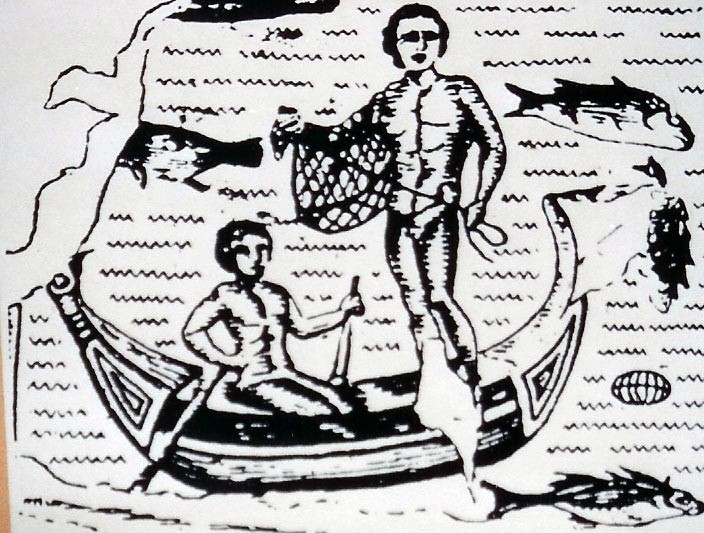
06.03.01.E. AN OLD ILLUSTRATION OF FISHERMEN FISHING WITH A CAST-NET. This illustration taken from a Roman mosaic in north Africa depicts a fisherman with a cast-net wearing only a loin cloth, but in doing so, he was considered to be “nude.”
[1]. Franz, “Ancient Harbors of the Sea of Galilee.” 114.
[2]. Bailey, Jesus through Middle Eastern Eyes. 142.
[3]. Barclay, “Matthew.” 2:88.
[4]. http://www.biblestudytools.com/lexicons/greek/nas/amphiblestron.html Retrieved December 7, 2013.
[5]. Vine, “Net.” Vine’s Complete Expository Dictionary. 2:430.
[6]. http://studybible.info/trench/Net. December 7, 2013.
[7]. Nun, The Sea of Galilee and its Fishermen in the New Testament. 12, 27.
06.03.02 Mk. 1:21-22 (See also Lk. 4:31-32) Capernaum
JESUS TEACHES AT CAPERNAUM, AN ECONOMIC CENTER
21 Then they went into Capernaum, and right away He entered the synagogue on the Sabbath and began to teach. 22 They were astonished at His teaching because, unlike the scribes, He was teaching them as one having authority.
Capernaum was an economic center for trade and international commerce and a popular stopping point for caravans that traveled between Europe, Asia, and northern Africa. It was here where Jesus located the center of His ministry. When he spoke in the synagogue, “they were astonished at His teaching.” Not only would the community people have been there, but also the traveling Jewish merchants would have attended and heard Him speak. Evidently Jesus left quite an impression, because previously He had acquired five disciples before He performed any miracles.
As a child, Jesus attended the local synagogue school in Nazareth and had no further education. Since He was not a seminary graduate and not ordained as a rabbi, He was not permitted to introduce a new interpretation, but He gave new insights and explained the ideals of the Kingdom of God with compassion and love. Furthermore, He taught with authority. Rabbis frequently quoted famous rabbis in their sermons. Jesus, however, said, “I say….” In essence, He said He was His own authority. Later this became more pronounced when He forgave sins, an act only God could do.
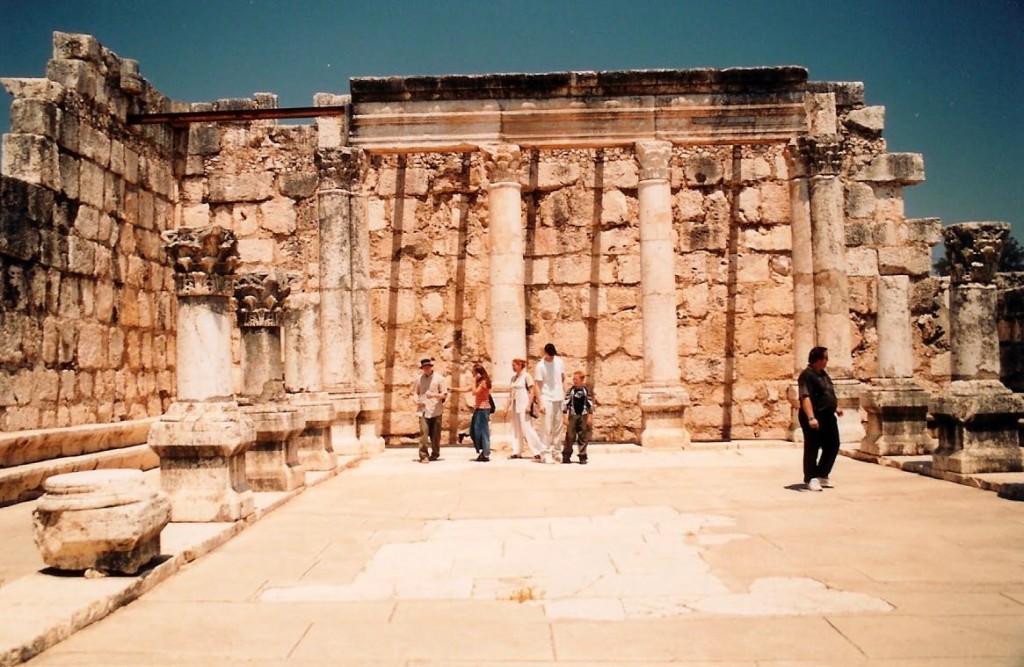
06.03.02.A. SYNAGOGUE AT CAPERNAUM. This late 3rd or early 4th century A.D. synagogue was made of white-colored limestone and constructed directly on top of the original synagogue in which Jesus preached. The massive columns and size of the sanctuary dwarf visitors. Photograph by the author.
At Capernaum traveling caravans loaded with goods, travelers, and religious pilgrims frequently stopped there for fresh supplies and salted fish.[1] Local craftsmen carved millstones and grinding stones from local volcanic basalt rock and sold them to traveling merchants. The Roman command post was located there, near today’s Greek Orthodox Church as evidenced by the ruins of a Roman bathhouse. That is probably where a centurion and his soldiers insured that travelers paid their taxes to a tax collector named Matthew.[2]
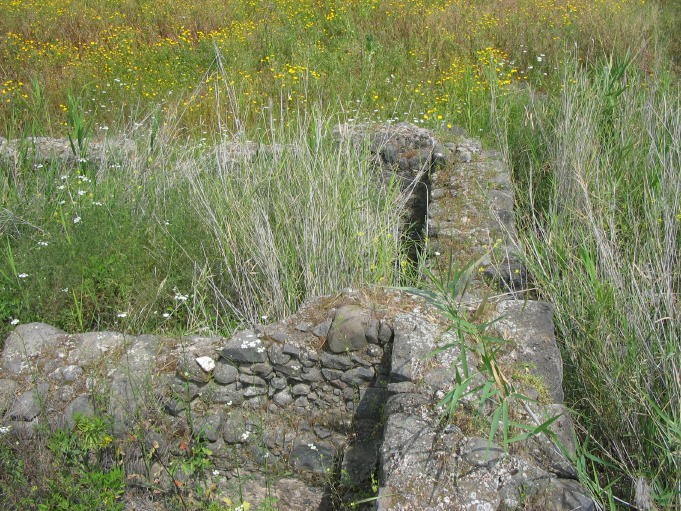
06.03.02.B. RUINS OF THE ROMAN BATHHOUSE AT CAPERNAUM. Grass and weeds bury the first century Roman bathhouse at Greek Orthodox Church in Capernaum. It is evidence of the presence of a Roman station that insured that travelers paid taxes to the agent of Rome – Matthew. Photograph by the author.
While Capernaum was known as a fishing village and a rest area for traveling caravans, there were probably several other industries located there as well. The surrounding farmland from Chorizim to Gadara was known for its excellent wheat that was used in the temple[3] and was also sold to caravans for export. Archaeologists have unearthed glass vessels that suggest a glass making industry or glass merchant, as well as dozens of grinding stones and stone implements made of the locally-found basalt rock.[4] These discoveries led them to conclude that the village had at least two thriving manufacturing industries.
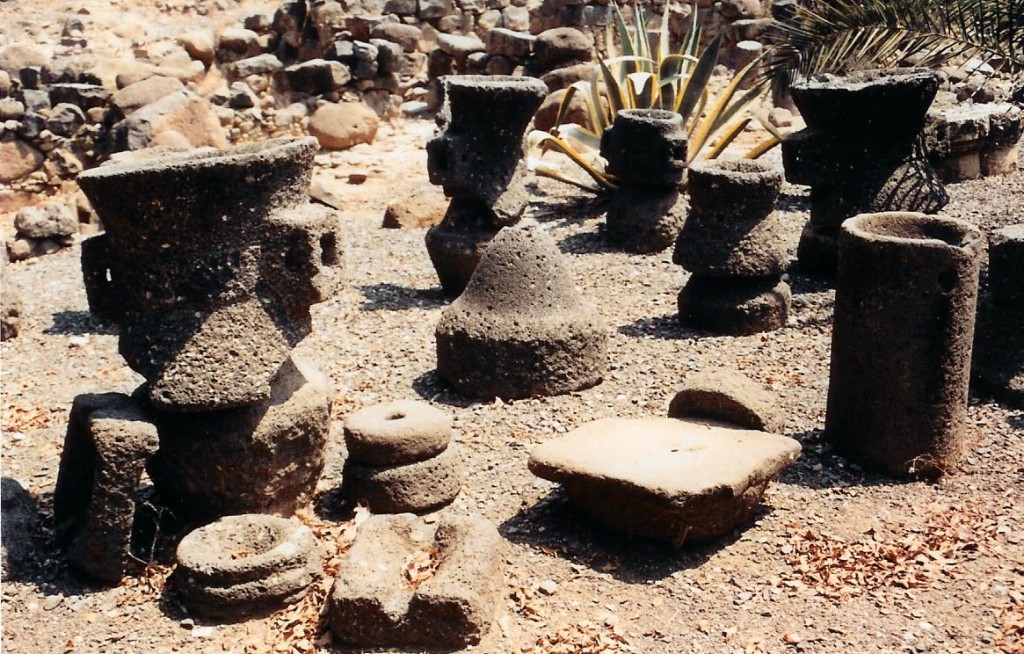
06.03.02.C. BASALT GRINDING STONES. Dozens volcanic basalt grinding stones have been uncovered in Capernaum, leading archaeologists to suspect there may have been a thriving stone industry in Capernaum at the time of Jesus. Photograph by the author.
The following image can be found in the full single-volume eBook of Mysteries of the Messiah as well as in the corresponding mini-volume. Search for the following reference number: 06.03.02.D. A CACHE OF GLASS VESSELS. Large quantities of glass vessels uncovered in Capernaum have led some archaeologists to consider the possibility of a glass merchant in the town. That in turn suggests Capernaum may have been a commercial center larger than was previously considered. Photograph by Stanislao Loffreda.
One of the fantastic treasures of Capernaum is the ruins of the house of Peter. The ruins of the village were first explored and identified by Edward Robinson. In the following years the Roman Catholic Franciscans protected the site from vandalism and began archaeological excavations. They uncovered a cache of glass vessels, basalt grinding stones of various sizes, and the home of St. Peter. Possibly most the interesting discovery is the collection of plaster pieces with various graffiti writings on them that identified the site as the former church that was built upon the ruins of St. Peter’s home.
The identity of where Peter and his family once lived has been preserved by an interesting event. Queen Helena, the mother of Constantine the Great, came to the Holy Land in the early fourth century. She honored the home of St. Peter by building a basilica over it that had three concentric octagons.[5] Her purpose was to preserve the location of the holy site.[6]
The following image can be found in the full single-volume eBook of Mysteries of the Messiah as well as in the corresponding mini-volume. Search for the following reference number: 06.03.02.E. DECORATED PLASTER PIECES FROM PETER’S HOME. Decorated plaster of floral design (3RD – 5TH century) and graffiti was found in the home / Church (or Basilica) of St. Peter.[7] The graffiti, written in nine languages, suggest that pilgrims from many countries visited this location.[8]
A Spanish nun, Egeria in the years 381-384[9] toured the Holy Land and visited the home of Peter. She noted that the Apostle’s home had been converted into a small church and made these comments:
The house of the prince of the apostles (St. Peter) in Capernaum was changed into a church; the walls, however, (of the house) are still standing as they were (in the past).
Pilgrim Egeria[10]
The foundations of Queen Helena’s basilica were also identified by an Italian pilgrim who came from the village of Piacenza in about the year 570. He stated that:
We came to Capernaum in St. Peter’s house, which at present is a basilica.
Pilgrim of Piacenza, Itinerarium[11]
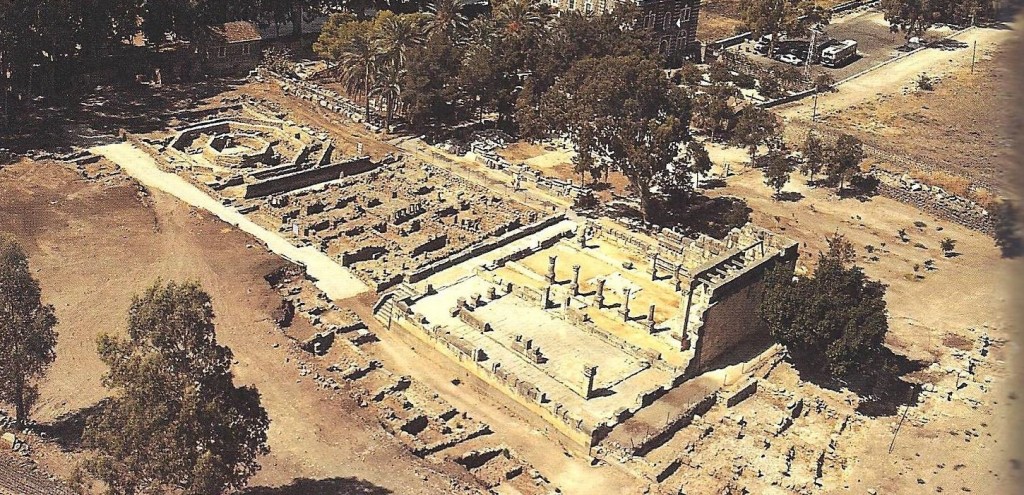
06.03.02.F. OCTAGONAL BYZANTINE FOUNDATIONS OVER PETER’S HOME. The ruins of Capernaum as seen from the air looking toward the Sea of Galilee. The three concentric octagonal walls on the left are the remains of a Byzantine church that was built around Saint Peter’s house. Today a Catholic shrine is suspended over the site. To the right are the partially reconstructed walls of the late 3rd century (A.D.) synagogue that was built over the synagogue in which Jesus taught. Photograph by Wikipedia Commons.
[1]. Pentecost, The Words and Works of Jesus Christ. 267.
[2]. Hansen, “The Sea of Galilee: An Overview.” 60-65.
[3]. Sources disagree on whether wheat from this area was used in the temple. While the quality was considered excellent, the Talmud (Men. 85a) states that distance made it prohibitive to ship it to Jerusalem. However, that may not have been the real reason because other sources state that no sacrifice could be taken across a defiled area such as Samaria in route to Jerusalem and, therefore, wheat from this area could not be used for the Omer sacrifice.
[4]. Loffreda, Recovering Capharnaum. 20-24.
[5]. It was not until excavations in 1968 that archaeologist discovered an apse and a baptistery, making it possible to identify this structure as a basilica. See http://theosophical.wordpress.com/2011/09/16/biblical-archaeology-38-peter%E2%80%99s-house-in-capernaum/ Retrieved September 18, 2012.
[6]. Shepherd, “Rediscovering the Kathisma: Where Mary Rested.” 47.
[7]. It was not until excavations in 1968 that archaeologist discovered an apse and a baptistery, making it possible to identify this structure as a basilica. See http://theosophical.wordpress.com/2011/09/16/biblical-archaeology-38-peter%E2%80%99s-house-in-capernaum/
[8]. Loffreda, A Visit to Capharnaum. 32-33.
[9]. Shanks, “After Hadrian’s Banishment: Jews in Christian Jerusalem.” 32.
[10]. Quoted by Loffreda, Recovering Capharnaum. 63.
[11]. Quoted by Loffreda, Recovering Capharnaum. 66; The work of Piacenza, Itinerarium, in English is Itinerary. Quoted by Wilkerson, Jerusalem Pilgrims Before the Crusades. 69; See also Piccirillo. “The Sanctuaries of the Baptism on the East Bank of the Jordan River.” 440-41.
06.03.03 Mk. 1:23-28 (See also Lk. 4:33-37) Jesus performed His first exorcism
MAN DELIVERED FROM A DEMON
23 Just then a man with an unclean spirit was in their synagogue. He cried out, 24 “What do You have to do with us, Jesus — Nazarene? Have You come to destroy us? I know who You are — the Holy One of God!”
25 But Jesus rebuked him and said, “Be quiet, and come out of him!” 26 And the unclean spirit convulsed him, shouted with a loud voice, and came out of him.
27 Then they were all amazed, so they began to argue with one another, saying, “What is this? A new teaching with authority! He commands even the unclean spirits, and they obey Him.” 28 News about Him then spread throughout the entire vicinity of Galilee.
The methods of casting out demons used by Jewish exorcists and healers were strongly opposed by Jesus. They used a wide variety of tactics that supposedly achieved success, including the use of animal organs, smoke, magical incantations, tricks, and the name of Solomon. This was in sharp contrast to Jesus who usually spoke the word and on rare occasion used mud and spit for a healing. Notice that the healing practices of the first century Jewish world were nearly identical to those practices that were commonly used by pagan healers. This reveals the magnitude to which Hellenism had penetrated into the core of Judaism. While it is believed by scholars that these practices were common knowledge, not all Jewish people accepted them; many preferring to call only upon the name of the Lord.
Then the young man questioned the angel and said to him, Brother Azariah, what medicinal value is there in the fish’s heart and liver, and in the gall?” He replied, “As for the fish’s heart and liver, you must burn them to make smoke in the presence of a man or woman afflicted by a demon or evil spirit, and every affliction will flee away and never remain with that person any longer.
Tobit 6:7-8[1]
“Be quiet.” Literally to be muzzled or gagged. [2] The demon could not speak even if he wanted to; Jesus politely but firmly commanded absolute and complete control. While Jewish exorcisms involved magical formulas,[3] Jesus cast out demons simply with His word.
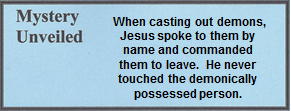
Ironically, the Jewish elite decided not to recognize Jesus for who He was, but the terrorized demons immediately recognized Him – the One who would deliver people from their strongholds and influence (Rev. 20:1-3). Unfortunately, English translations miss the sense of terror the demons expressed in this passage.
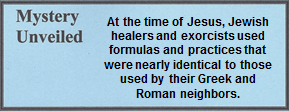
Here, for the first time, Jesus exercised His divine power over demonic spirits. Demons influence and sometimes control the thinking, speaking, feeling, and actions of their victims and, therefore, the demon’s desires are revealed.[4] The approach Jesus used was uniquely different from others who practiced exorcisms. He always spoke to the demons but never touched the possessed persons. This is in sharp contrast to the many times he touched the sick, infirm, and even the dead.
In the process of casting out demons, Jewish and pagan exorcists followed prescribed formulas and repeatedly called upon the name of their god to cast out demons. Some rabbis believed that, by their secret spells, they could command the services of spirits for good or evil.[5] An example is the magical spell, repeated for emphasis, in the book of Tobit. It reads,
As he went … he took the live ashes of incense and put the heart and liver of the fish upon them and made a smoke. And when the demon smelled the odor, he fled to the remotest parts of Egypt, and the angel bound him.
Tobit 8:2-3
It should be noted that in Greek thinking, demons were supernatural beings that could be either good or bad spirits,[6] but biblical writers identified the spirits only as evil.
[1]. Ben Sirach and Tobit belong to a classification of extra-biblical books known as the Apocrypha. These two literary works reflect the opinions of many Jewish people. See 02.02.03 “Apocrypha” for more information. The reader is reminded that quotations from non-biblical sources are not to be understood as being of equal authority with the biblical narratives. See 01.02.04.
[2]. Vincent, Word Studies in the New Testament. 1:165.
[3]. Tobit 5:7-8; Josephus, Antiquities 8.2.5 (45-49).
[4]. Pentecost, The Words and Works of Jesus Christ. 145.
[5]. Geikie, The Life and Works of Christ. 1:367.
[6]. New International Version Study Bible footnote on Luke 4:33.
06.03.04 Mk. 1:29-31; Lk. 4:39 (See also Mt. 8:14-15; Lk. 4:38-39) Capernaum
PETER’S MOTHER-IN-LAW HEALED
Mt. 29 As soon as they left the synagogue, they went into Simon and Andrew’s house with James and John. 30 Simon’s mother-in-law was lying in bed with a fever, and they told Him about her at once. 31 So He went to her, took her by the hand, and raised her up.
Lk. 39 So He stood over her and rebuked the fever, and it left her. She got up immediately and began to serve them.
After the synagogue service, it was the custom for people to enjoy a meal with friends, so Jesus went to the home of Peter. It is said that Peter’s mother-in-law was ill, but it is unknown if she was sick in bed or if she became ill after the synagogue service. Either way, by the time Jesus arrived at Peter’s house she had “a fever.”
“Simon’s mother-in-law.” Simon had no shortage of names, and is also known as “Peter,” “Simon ben Johan/bar Jonah,” “Simon Peter,” “Cephas,” and “Kepha.” As with all the disciples, little is known of their families. But concerning Peter, he was obviously marked and may have had a son (1 Pet. 5:13) and his wife eventually joined him on some missionary journeys (1 Cor. 9:5).
06.03.04.Q1 Why is the healing of Peter’s mother-in-law to be considered more than a healing miracle?
The significance lies in the term “a fever.” There were three kinds of fevers in the Galilee and surrounding areas, because Galilee was different than Perea and Judah. Those two areas were too dry to have mosquito-infested marshy areas. In Luke 4:38, the physician said the fever was great, suggesting its seriousness.[1] Ancient physicians marked the difference between a light and great fever.[2]
A short distance north of the Sea of Galilee is the Hula Lake, which was surrounded by a large marshy area.[4] It was always a mosquito-infested swamp and travelers always risked getting Malta fever, malaria, or typhoid. All three of these diseases generally resulted in death.[5] According to Alfred Edersheim, the Talmud identifies this disease as the eshatha tsemirta, meaning, “a burning fever,”[6] which suggests that she had one of these terminal diseases.
Jewish writings reveal the extent to which pagan superstitions had infiltrated Judaism. It appears that some rabbis imitated Greek healing practices because basic elements were similar.[7] For example, the prescribed healing method for a fever recorded in the Talmud involved tying an iron knife to a thorn bush with the hair of the sick person attached. This was repeated several consecutive days, after which the bush was cut down while a magical formula was announced.[8] Objects of iron, such as nails and knives, were in much demand and were said to hold magical powers to ward off evil.[9]
Luke said that Jesus rebuked the fever. The healing was more than a miracle because Jesus not only healed Peter’s mother-in-law, but demonstrated power over the superstitions and ridiculous methods of the rabbis. The narrative reflects the same manner in which He rebuked demons, which implies the source of the fever.[10] As mentioned previously, Jesus never touched anyone with demonic spirits, but He commanded them to leave as He did with the burning fever. This story is far more dynamic than the healing, which was a phenomenon in its own right.
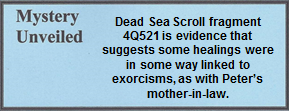
The Jewish people had a number of incredible legends and superstitions they believed would either heal a person or cast out demons. One of them was recorded by Josephus.
In the Valley of Baaras there is a certain root called by the same name. Its color is like to that of flame, and towards evening it sends out a certain ray like lightning. It is not easily taken by such as would do so, but recedes from their hands, nor will it yield itself to be taken quietly until either the urine of a woman, or her menstrual blood, be poured upon it; no, even then it is certain death to those who touch it, unless anyone take and hang the root itself down from his hand, and so carry it away.
It may also be taken another way without danger, which is this: they dig a trench all around it, until the hidden part of the root be very small; they then tie a dog to it, and when the dog tries hard to follow him that tied him, the root is easily plucked up, but the dog dies immediately instead of the man who would take the plant away; nor after this need anyone be afraid of taking it into their hands. Yet after all these pains in getting it, it is only valuable on account of one virtue which it possesses, that if it be brought to sick persons, it drives away those called demons.
Josephus, Wars 7.6.3 (180-185)
This interesting point of superstitious folklore is that they reveal that the Jewish people had more faith for healing in a variety of places, but not in the God of Abraham, Isaac, and Jacob. Jesus was about to change their perception of Who does the healing.
“Began to serve them.” She functioned as the Greek diaconate or, as would be known after Pentecost, a deaconess of the church.[11]
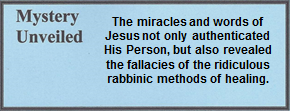
[1]. Concerning medical procedures available in the first century Israel, a number of good resources have been published by the University of Haifa, Hebrew University, and the Israel Museum. For further study, see the articles published in Michmanim, (English and Hebrew), Haifa, Israel: University of Haifa (Vol. 13) May, 1999.
[2]. Vincent, Word Studies in the New Testament. 1:295.
[3]. This disease is known by several names, including the Mediterranean fever. It is caused by a bacteria from infected milk or undercooked meat.
[4]. Also known as the plain of El Huleh, or the Sea of Merom,
[5]. Barclay, “Matthew.” 1:307-08.
[6]. Alfred Edersheim (18125-1889) was a Jewish scholar who converted to Christianity, and whose writings are considered by scholars as classic; Edersheim, The Life and Times of Jesus the Messiah. 336-37. He is clearly a rich source for the understanding of first century Jewish traditions. However, he has his bias in that he is anti-Pharisaic and anti-Rabbinic. Therefore, he has a tendency to be less than historically accurate on some issues.
[7]. The Greeks likewise had their own superstitious methods of exorcisms that included wild and frenzied dancing with singing and chanting. These components were not in Jewish exorcisms. For more information, see Ustinova, “Treating Madness with Madness: The Greek Corybantes.” 26.
[8]. Edersheim, The Life and Times of Jesus the Messiah. 336.
[9]. Stans, “Crucifixion Evidence.” 6.
[10]. Read the discussion on healing and exorcisms written in Dead Sea Scroll fragment 4Q521 at the end of 08.05.04.
[11]. Edersheim, The Life and Times of Jesus the Messiah. 336.
06.03.05 Mk. 1:32-34 (See also Mt. 8:16-17; Lk. 4:40-41) Capernaum
MANY WERE HEALED
32 When evening came, after the sun had set, they began bringing to Him all those who were sick and those who were demon-possessed. 33 The whole town was assembled at the door, 34 and He healed many who were sick with various diseases and drove out many demons. But He would not permit the demons to speak, because they knew Him.
“When evening came, after the sun had set.” The people who desired to be obedient to God’s commands naturally obeyed the teachings of their rabbis and did not want to break the Sabbath day regulations by requesting a healing. Therefore, they waited until the Sabbath was over; after the sun had set and at least three medium-sized stars were in the sky.[1] This was the “second evening” of the day[2] when they brought their sick and demon-possessed to Jesus to be healed and delivered.[3] Why three stars? Because two or three witnesses were needed to render a judgment and three stars in the sky determined when a day began or ended (Deut. 17:6).
“The whole town was assembled at the door.” The popularity of Jesus continued to grow exponentially. The Jordan Valley had a healing reputation as foreigners came to sit in the natural hot springs as found in Tiberias. Now Jesus, who functioned with the power of the God of Abraham, Isaac, and Jacob, was healing men, women, and children including those who failed to get healed in the natural hot springs. But with popularity came a serious set of problems:
“Various diseases…demons.” Demons are synonymous with unclean spirits,[4] who are connected with Satan,[5] and in total opposition to the work of God,[6] and as such, promote all forms of idolatry.[7] They oppose the faith of believers,[8] and attempt to influence and disturb the physical, mental and emotional well-being of people.[9] However, while certain ailments may be connected with demonic powers, the laws of Moses that pertain to sanitation clearly indicate that good health is also a matter of cleanliness – meaning that many diseases are not related to demonic influences but can be prevented.
[1]. See discussion on “evening” in Appendix 16.
[2]. See Appendix 16 for clarification on the two daily evenings.
[3]. Farrar, Life of Christ. 110.
[4]. Mk. 5:12, 15; 3:22, 30; Lk. 4:33.
[5]. Lk. 10:17-18; 11:19-20.
[6]. 1 Cor. 10:20-21.
[7]. Rev. 9:20; 16:13-14.
[8]. 1 Tim. 4:1.
[9]. Lk. 13:11, 16; Mk. 5:2-5; 7:25; Mt. 12:45.
06.03.06 Mk. 1:35-38 (See also Lk. 4:42-43)
JESUS GOES OUT TO PRAY
35 Very early in the morning, while it was still dark, He got up, went out, and made His way to a deserted place. And He was praying there. 36 Simon and his companions went searching for Him. 37 They found Him and said, “Everyone’s looking for You!”
38 And He said to them, “Let’s go on to the neighboring villages so that I may preach there too. This is why I have come.”
“To a deserted place.” Some translations use the word “desert,” rather than a solitary and quiet or deserted area.[1] However, there was no desert near the Sea of Galilee (cf. Mk. 1:35; Lk. 4:42), but rather, it is a lush, green, productive farmland with quite peaceful areas on the hill and mountain tops where few, if anyone, lived – deserted places. The gospel writer is saying that Jesus had to retreat to a quiet area and spend hours in prayer. His humanity is revealed in that ministry exhausted Him physically and emotionally.
“He was praying there.” Jesus was often in prayer. It was His source of strength, especially when He knew difficulties lay immediately ahead. In his busiest period, when He was so often exhausted from the labors of the day, He retreated to a secluded place away from the crowds and disciples to pray with His Father. He never took any important step without such a night. It is amazing that Jesus spent many long hours in prayer, yet only His short prayers have been recorded.
[1]. For example, the King James Version.